Following the end of WW2 although Britain had won the war, the country was almost bankrupt and the British Empire was in decline and looming over everything was the spectre of the cold war. What everyone needed was a party and this led to plans for The Festival Of Britain which was an immense success attracting millions of visitors from Britain and overseas.
The Festival was held in June 1951, the centenary of the Great Exhibition in Hyde Park. The Festival was centred on the South Bank of The River Thames in London. Close to the South Bank the Festival Gardens were established in Battersea Park opening on 3 May 1951. While many festival sites were looking forward at Britain’s future, the concept of the Festival Pleasure Gardens was looking back, a celebration of nostalgia, eccentricity and fun. Nothing summed this up better than the Far Tottering And Oyster Creek Branch Railway.
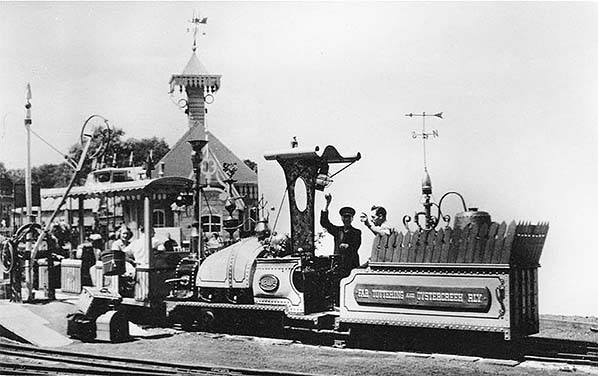 There were three locomotives on the Far Totting & Oyster Creek Railway. This is No 1,Nellie
There were three locomotives on the Far Totting & Oyster Creek Railway. This is No 1,Nellie
Photo from John Mann collection
The railway was the brainchild of Rowland Emett a former draughtsman for the air ministry. Emett was a cartoonist and sculptor who became popular in the 1940s through his cartoons in Punch magazine. He is most famous for his train cartoons which depicted bizarre and ramshackle locomotives bumbling through the countryside. A parody of the kind of railways that had criss crossed Britain in the early 20th century, a whimsical view of British rural life and embodying his typical fanciful mechanics. Emett was specifically inspired by the Hundred of Manhood and Selsey Tramway in Sussex.
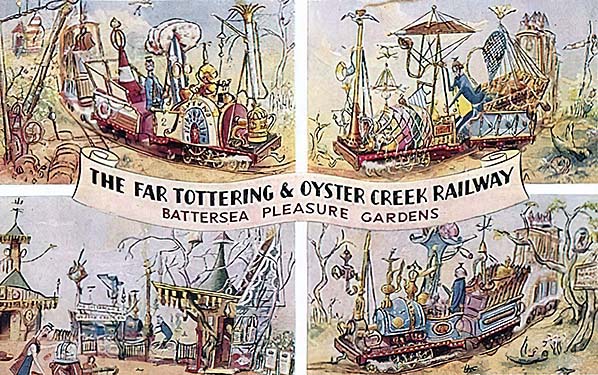
His cartoons were so popular in the 1940s that they even inspired RAF slang. Bombing a branch line was known as 'strafing an Emett'. For the Pleasure Gardens, Emett was asked to bring his drawings to life. The railway was originally to be called the Far Twittering and Oyster Perch Railway but as there was already a radio show set in a fictional town called Twittering, his fictional railway was to run from Far Tottering to Oyster Creek. The railway was built to 15" gauge. The internal workings of the locomotives were built by Harry Nuttall Barlow who was a name famous within miniature railway circles. Barlow was an engineer from Birkdale in Southport who had been involved with the Lakeside Miniature Railway (which opened as The Llewelyn Miniature Railway in 1911) between Southport's marine lakes since the 1930s. In 1945 he purchased the line and had always acknowledged the impracticality of operating steam locomotives on this popular and busy tourist attraction. Barlow designed his own diesel electric locomotive. His first locomotive built in Southport which was powered by a second hand war surplus Fordson Major 4-cyl diesel coupled to a Tilling Stevens generator which was located in the locos tender. A series of cables took 110v to a centrally mounted traction motor and differential which in turn drove the driving axles on the front half of the locomotive.
The loco had bodywork inspired by Sir Nigel Gresley's A4 Pacific. It was named Duke of Edinburgh and arrived at the Lakeside Miniature Railway in 1948. The locomotive was a great success and it was decided that Barlow's tried and tested chassis would form the basis for Emett's locomotives. All three locomotives were constructed at Barlow's workshop in Birkdale and were tested on the Lakeside Miniature Railway before making the journey south to Battersea.
Emett's role was what is known in Disney circles as ‘imagineering’ bringing his mad cartoons into the real world. He designed and supervised and entire bizarre world of stations, signals, tunnels and trains. There were signs asking passengers not to "tease the engines" and stating "trains cross here .... so there".
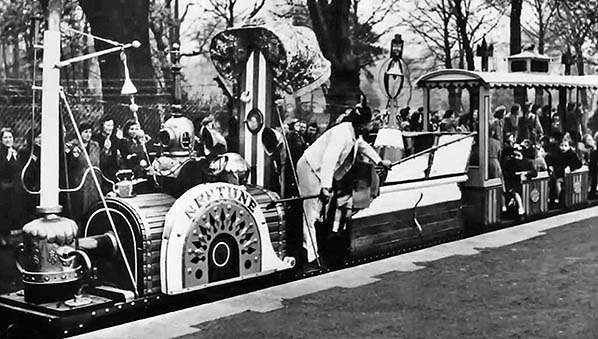 Locomotive No. 2 Neptune.
Locomotive No. 2 Neptune.
Photo from John Mann collection
There were three engines, the first was Nellie. The name Nellie popped up in many of Emett's cartoons so it was inevitable that it would appear at Far Tottering. By Emett's standards this was a fairly conventional locomotive. The second was Neptune, supposedly built from the wreck of a paddle steamer. The third was Wild Goose apparently built around an airship. All three were of the 4-6-2 wheel arrangement which on main line railways is a wheel arrangement reserved for express locomotives. Due to the layout of the line (single, sharply curved, with tunnels) it was operated on a form of token system, whereby the trains themselves formed the token. As three trains would be in operation at any one time, and each station had two platforms (one train at each of the two stations, one moving going into the empty platform at the terminus), a train was safe to proceed if the driver could see another train in the platform next to them. The ⅓ mile line opened on 11 May 1951 and carried over 1000 visitors an hour while maintaining a three train operation The line was a huge success with only one event casting a shadow. On 11 July 1951, two full trains approached head-on on the single track section, close to Oyster Creek station. There was a collision between Nellie and Wild Goose which resulted in the death of a lady, Mrs Roberts with 12 to 13 other people being injured. It is unknown what sequence of events caused this to happen and there doesn't appear to have been a parliamentary inquiry after the accident. The verdict was 'accidental death' and no blame was placed on Emett, parliament was quick to assert. The railway ran a single train service while the other two locomotives were repaired.
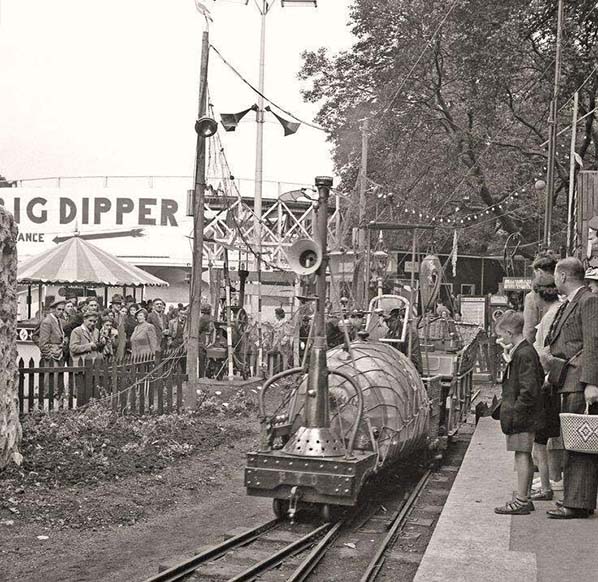 Locomotive No 3, Wild Goose
Locomotive No 3, Wild Goose
Photo from John Mann collection
Despite the lines undoubted popularity it was only intended to be temporary. When the Festival ended the line to Oyster Creek closed on 3 November 1951. The park and Battersea Funfair remained and the railway continued to run until 1953. Then it was moved to a different part of the park and reopened as The Festival Gardens Railway. The new 840 yard line ran from a station called Queens Town Road from where it followed the course of Carriage Drive East on its east side before turning east on the south side of Carriage Drive North to terminate at Chelsea Bridge station. There was also a station with a passing loop close to the Funfair. Queenstown Road had an island platform with a loop on both sides and Chelsea Bridge had a single platform with a loop. There was a two road shed on a short branch north of Queenstown Road station.
When the line was moved the locos had to be rebuilt as their design was copyrighted by Rowland Emett. All three locomotives were taken back to Barlow's workshop and converted to his Gresley inspired A4 design. Nellie was rebuilt at Princess Anne, Wild Goose was rebuilt at Princess Margaret and both were taken back to Battersea. At the time Barlow was building a new loco for the Saltburn Miniature Railway called Prince Charles. It was decided that Neptune, once converted would share the same name and once completed in 1954 Prince Charles joined Barlow's own fleet of locomotives at Lakeside.
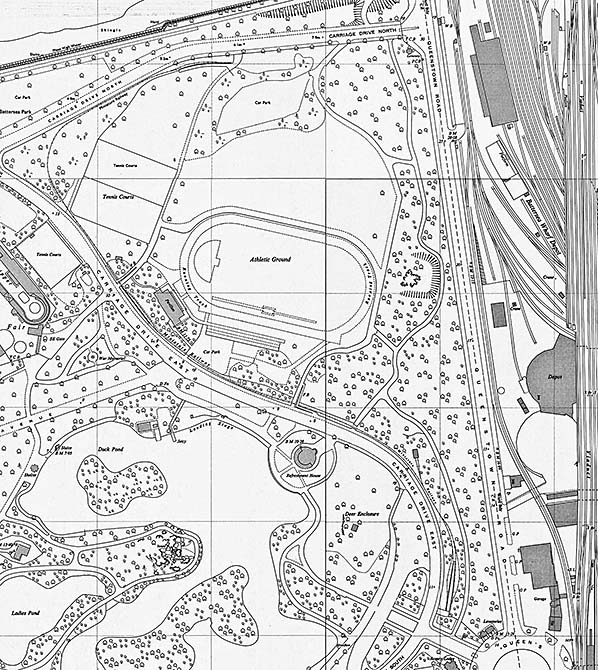 1960 1:1,250 OS map show the line running to the east of Carriage Drive East before turning west to the Chelsea Bridge terminus on the south side of Carriage Drive North. There was an intermediate station to the west of The Pavilion. A two road engine shed is seen to the north of the southern terminus at Queenstown Road. Click here to see a larger version of the map.
1960 1:1,250 OS map show the line running to the east of Carriage Drive East before turning west to the Chelsea Bridge terminus on the south side of Carriage Drive North. There was an intermediate station to the west of The Pavilion. A two road engine shed is seen to the north of the southern terminus at Queenstown Road. Click here to see a larger version of the map.
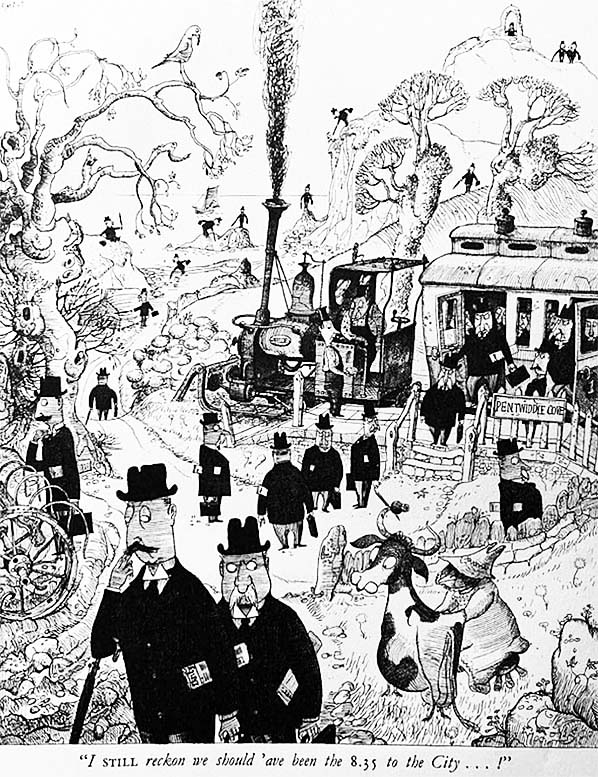 Nellie in a spot of trouble.
Nellie in a spot of trouble.
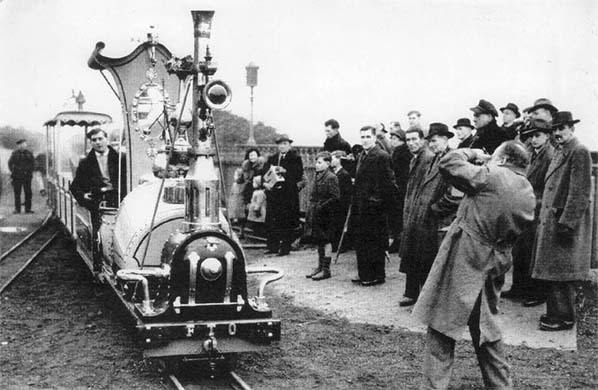 Saddle tank Nellie is the most photographed locomotive on the line.
Saddle tank Nellie is the most photographed locomotive on the line.
Photo from John Mann collection
The Battersea Park line was rarely used after 1965 but officially it ran until 1972 but when the tired and unreliable locos were retired and put into storage. There were no further trains until 1975 when the line officially closed although photos taken in 1973 show some sections of track had been lifted. The remaining track was lifted in 1975 and the locos were sold and placed in storage until 1977. By this time they were in a poor state due to vandalism with copper wire being stripped out leaving it virtually written off. The two locos were moved to Portsmouth where there were plans to open a 15" railway at the Medina Valley on the Isle of Wight. The plans never came to fruition and both locos were eventually sold as scrap in 1982.
With only one former Battersea locomotive now named Prince Charles remaining The Lakeside Miniature Railway as the Southport line was now called, was sold in 2001. Prince Charles was due a major refurbishment with conversion from diesel electric to diesel hydraulic. The loco was moved to the Windmill Farm Railway for the rebuild but this never completed. It was stripped of its Fordson engine and Tilling Stevens generator but the conversion was never completed. The shell and rolling chassis are still at the Windmill Farm Railway the loco has been on display at the railway workshop on a number of occasions awaiting completion of its conversion.
Part of a cutting for the Festival Gardens Railway is still visible near the tennis courts in Battersea Park.
Emett's career flourished after the festival. His interest turned more towards kinetic sculptures many of which survive in working order. His best know works are his designs for the film Chitty Chitty Bang Bang with the inventions of Caractacus Potts.
Click here to see British Movietone film (no sound) of the Far Tottering And Oyster Creek Branch Railway
Click here to see Jago Hazzard's short documentary The Far Tottering and Oyster Creek Branch Railway: The Weirdest Railway Ever?
Click here to see another documentary about the Far Tottering And Oyster Creek Branch Railway including more film (with sound) of the line.
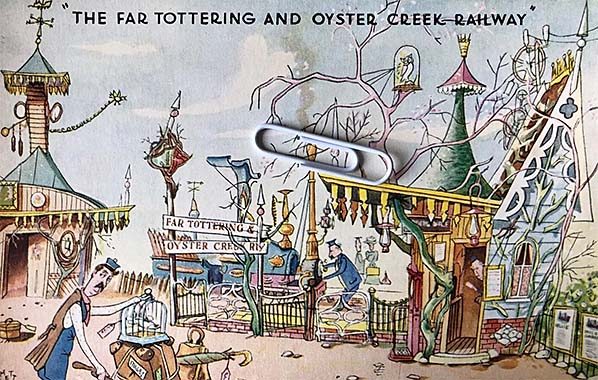
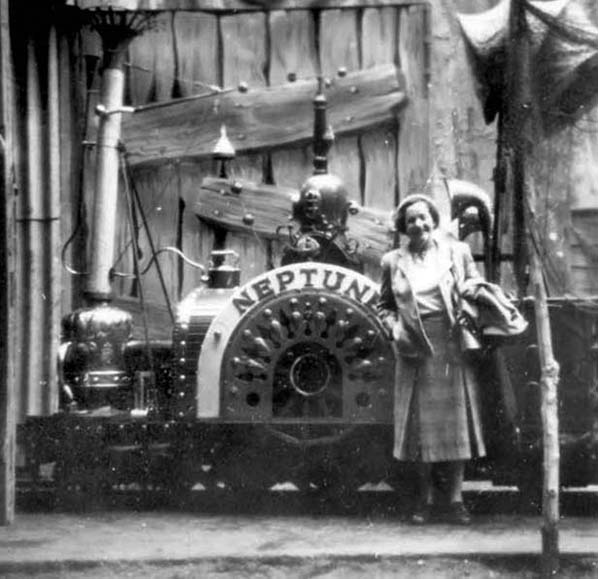 Neptune in 1951.
Neptune in 1951.
Photo by John Phillips
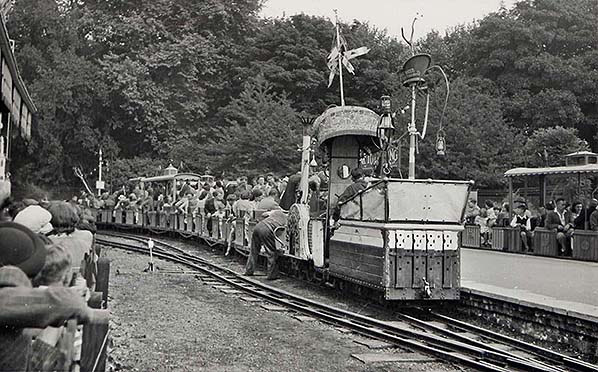 Each station consisted of two platforms with two run round loops. Rather than exchanging a single line token the train itself acted as the drivers token and the driver was allowed to proceed so long as he could see another train next to him on departure.
Each station consisted of two platforms with two run round loops. Rather than exchanging a single line token the train itself acted as the drivers token and the driver was allowed to proceed so long as he could see another train next to him on departure.
Photo from John Mann collection
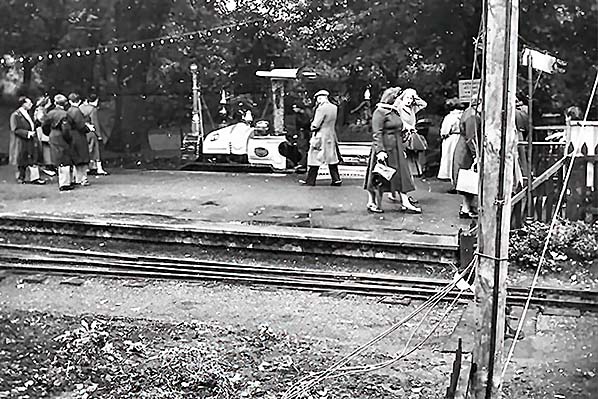 No 1 locomotive Nellie.
No 1 locomotive Nellie.
Photo from Wikipedia, reproduced under creative commons licence
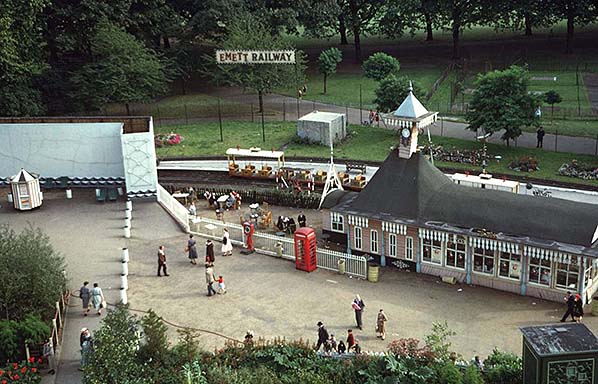 A nice colour view of Rowland Emett's railway 1n 1953.
A nice colour view of Rowland Emett's railway 1n 1953.
12.jpg) Chelsea Bridge station, the northern terminus of the Festival Gardens Railway in May 1967.The railway was still officially open at this date but saw little use.
Chelsea Bridge station, the northern terminus of the Festival Gardens Railway in May 1967.The railway was still officially open at this date but saw little use.
Photo by Nick Catford
13.jpg) Chelsea Bridge station, the northern terminus of the Festival Gardens Railway in May 1967. Chelsea Bridge over the River Thames can just be made out in the distance under the station sign.
Chelsea Bridge station, the northern terminus of the Festival Gardens Railway in May 1967. Chelsea Bridge over the River Thames can just be made out in the distance under the station sign.
Photo by Nick Catford
14.jpg) Funfair, the intermediate station on the Festival Gardens Railway in August 1973. The railway closed in 1972 when the two locomotives were taken out of service. The track wasn't lifted until 1975 when the railway officially closed.
Funfair, the intermediate station on the Festival Gardens Railway in August 1973. The railway closed in 1972 when the two locomotives were taken out of service. The track wasn't lifted until 1975 when the railway officially closed.
Photo by David Flett from his Flickr Photostream
15.jpg) Looking north along the Festival Gardens Railway from Queenstown Road station in August 1973. All the stations on the line had a run round loop.
Looking north along the Festival Gardens Railway from Queenstown Road station in August 1973. All the stations on the line had a run round loop.
Photo by David Flett from his Flickr Photostream
16.jpg) Queenstown Road station looking north in August 1973. The railway closed when the two locomotives were taken out of service in 1972. Although the railway didn't officially closed till 1975 some track has already been lifted.
Queenstown Road station looking north in August 1973. The railway closed when the two locomotives were taken out of service in 1972. Although the railway didn't officially closed till 1975 some track has already been lifted.
Photo by David Flett from his Flickr Photostream
17.jpg) The engine shed located on a short branch north of Queenstown Road station in August 1973
.
The engine shed located on a short branch north of Queenstown Road station in August 1973
.
Photo by David Flett from his Flickr Photostream
Sources :

